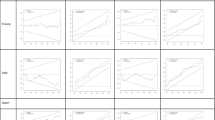Abstract
The relationship between exchange-rate volatility and aggregate export volumes is examined using a model that includes real export earnings of oil-exporting economies as a determinant of export volumes of a sample of 12 industrial countries. Four fixed-coefficient panel-data estimation techniques, including a generalized method of moments (GMM) and random coefficient (RC) estimation, are employed on panel data covering the estimation period 1977:1–2003:4 using three measures of exchange-rate volatility. Our aim is to provide a theoretically and empirically justifiable specification that can guide researchers. In contrast to recent studies employing panel data, we find little evidence that volatility has a negative and significant impact on trade. We use second-generation RC estimation, which corrects for biases arising from incorrect functional forms, omitted variables, and measurement errors. Our results suggest that the finding of a significant and negative impact of volatility is attributable to specification biases.
Similar content being viewed by others
References
Anderson, J. E., and E. van Wincoop (2003). Gravity with Gravitas: A Solution to the Border Puzzle. American Economic Review 93 (1): 170–192.
Arellano, M., and S. R. Bond (1991). Some Tests of Specification for Panel Data: Monte Carlo Evidence and an Application to Employment Equations. Review of Economic Studies 58 (2): 277–297.
Bailey, M. J., G. S. Tavlas, and M. Ulan (1986). Exchange Rate Variability and Trade Performance: Evidence for the Big Seven Industrial Countries. Weltwirtschaftliches Archiv/Review of World Economics 122 (3): 466–477.
Bailey, M. J., G. S. Tavlas, and M. Ulan (1987). The Impact of Exchange Rate Volatility on Export Growth: Some Theoretical Considerations and Empirical Results. Journal of Policy Modeling 9 (1): 225–243.
Baltagi, B. (2001). Econometric Analysis of Panel Data. Second Edition. Chichester: Wiley.
Chang, I., P. A. V. B. Swamy, C. Hallahan, and G. S. Tavlas (2000). A Computational Approach to Finding Causal Economic Laws. Computational Economics 16 (1–2): 105–136.
Chou, W. (2000). Exchange Rate Variability and China’s Exports. Journal of Comparative Economics 28: 61–79.
Christou, C., P. A. V. B. Swamy, and G. S. Tavlas (1998). A General Framework for Predicting Returns from Multiple Currency Investments. Journal of Economic Dynamics & Control 22 (7): 977–1000.
Clark, P., N. Tamirisa, and S. J. Wei (2004). A New Look at Exchange Rate Volatility and Trade Flows. Occasional Papers 235. International Monetary Fund, Washington, D.C.
Coric, B,. and G. Pugh (2006). The Effects of Exchange Rate Variability on International Trade: A Meta Regression Analysis. IESR Working Paper 01-2006. Institute for Environment and Sustainability Research, Staffordshire University, UK.
De Grauwe, P. (2005). The Economics of Monetary Union. Sixth Revised Edition. Oxford: Oxford University Press.
Dell’Ariccia, G. (1999). Exchange Rate Fluctuations and Trade Flows: Evidence from the European Union. IMF Staff Papers 46 (3): 315–334.
Dellas, H., and B. Z. Zilberfarb (1993). Real Exchange Rate Volatility and International Trade: A Re-examination of the Theory. Southern Economic Journal 59 (4): 641–647.
Edison, H. J., and M. Melvin (1990). The Determinants and Implications of the Choice of an Exchange Rate System. In W. S. Haraf and T. D. Willett (eds.), Monetary Policy for a Volatile Global Economy. Washington, D.C.: AEI Press.
Greene, W. H. (2003). Econometric Analysis. Fifth Edition. Upper Saddle River, New Jersey: Prentice Hall.
Hansen, L. P. (1982). Large Sample Properties of Generalized Method of Moments Estimators. Econometrica 50 (4): 1029–1054.
IMF (International Monetary Fund Research Department) (1984). Exchange Rate Volatility and World Trade. Occasional Papers 28/7/84. International Monetary Fund, Washington, D.C.
McKenzie, M. D. (1999). The Impact of Exchange Rate Volatility on International Trade Flows. Journal of Economic Surveys 13 (1): 71–106.
Rose, A. (2000). One Money, One Market: Estimating the Effect of Common Currencies on Trade. Economic Policy 15 (30): 7–46.
Sargan, J. D. (1964). Wages and Prices in the United Kingdom: A Study in Econometric Methodology. In P. E. Hart, G. Mills, and J. K. Whitaker (eds.), Econometric Analysis for National Economic Planning. London: Batterworths.
Siregar, R., and R. S. Rajan (2004). Impact of Exchange Rate Volatility on Indonesia’s Trade Performance in the 1990s. Journal of the Japanese and International Economies 18 (2): 218–240.
Swamy, P. A. V. B., and S. S. Arora (1972). The Exact Finite Sample Properties of the Estimators of Coefficients in the Error Components Model. Econometrica 40 (2): 261–275.
Swamy, P. A. V. B., and G. S. Tavlas (1994). Connections between GARCH and Stochastic Coefficients (SC) Models. Economics Letters 46 (1): 7–10.
Swamy, P. A. V. B., and G. S. Tavlas (2001). Random Coefficient Models. In B. H. Baltagi (ed.), A Companion to Theoretical Econometrics. Malden, MA: Blackwell.
Swamy, P. A. V. B., and G. S. Tavlas (2005). Theoretical Conditions under Which Monetary Policies Are Effective and Practical Obstacles to Their Verification. Economic Theory 25 (4): 999–1005.
Swamy, P. A. V. B., and G. S. Tavlas (2006). A Note on Muth’s Rational Expectations Hypothesis: A Time-Varying Coefficient Interpretation. Macroeconomic Dynamics 10 (3): 415–425.
Swamy, P. A. V. B., and G. S. Tavlas (2007). The New Keynesian Phillips Curve and Inflation Expectations: Re-specification and Interpretation. Economic Theory 31 (2): 293–306.
Swamy, P. A. V. B., and P. A. Tinsley (1980). Linear Prediction and Estimation Methods for Regression Models with Stationary Stochastic Coefficients. Journal of Econometrics 12 (2): 103–142.
Swamy, P. A. V. B., I. Chang, J. S. Mehta, and G. S. Tavlas (2003). Correcting for Omitted-Variable and Measurement-Error Bias in Autoregressive Model Estimation with Panel Data. Computational Economics 22 (2): 225–253.
Tenreyro, S. (2004). On the Trade Impact of Nominal Exchange Rate Volatility. Federal Reserve Bank of Boston, unpublished.
Verbeek, M. (2004). A Guide to Modern Econometrics. Second Edition. Chichester: Wiley.
Wei, S. J. (1999). Currency Hedging and Goods Trade. European Economic Review 43 (7): 1371–1394.
Zellner, A. (1988). Causality and Causal Laws in Economics. Journal of Econometrics 39 (1–2): 7–21.
Author information
Authors and Affiliations
Corresponding author
Additional information
JEL no.
C23, F3, F31
About this article
Cite this article
Hondroyiannis, G., Swamy, P., Tavlas, G. et al. Some Further Evidence on Exchange-Rate Volatility and Exports. Rev. World Econ. 144, 151–180 (2008). https://doi.org/10.1007/s10290-008-0141-4
Issue Date:
DOI: https://doi.org/10.1007/s10290-008-0141-4




